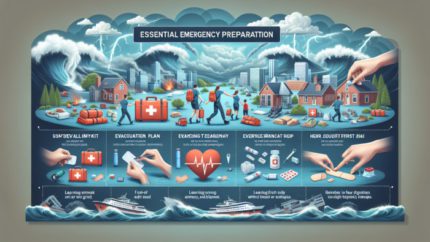Comprehending the Dangers of Heatwaves
Heat waves are far more than just seasonal inconveniences; they profoundly threaten human health and societal stability. Gripping the complexities of heat waves is essential in the critical context of surviving extreme heat. When temperatures rise significantly above the average, there is an urgent need for public awareness and preparedness strategies, especially in regions that are increasingly experiencing such weather phenomena.
Defining Extreme Heat and Its Implications

Extreme heat is defined by temperatures that surge dramatically above the usual averages, frequently exceeding 30°C (86°F) in various areas, and can soar much higher in regions like the Middle East or parts of Australia. The World Health Organisation categorises heat waves as prolonged periods of excessive heat lasting several days, and these events can be particularly perilous for vulnerable groups such as the elderly, children, and individuals with pre-existing health issues. As urban areas expand, the heat island effect—where city landscapes absorb and radiate heat—intensifies these conditions, highlighting the necessity of educating the public on recognising the signs of heat-related illnesses and the precautions needed to safeguard against them.
Recognising the health risks linked to extreme heat is imperative. Conditions such as heat exhaustion, heat cramps, and heat stroke can develop swiftly when the body cannot cool itself effectively. Symptoms may manifest as heavy sweating, profound weakness, confusion, and fainting. For those focused on surviving extreme heat, early recognition of these symptoms can be the key difference between managing a situation and facing a medical emergency.
The Mechanisms That Drive Heatwaves
The origins of heat waves are often associated with high-pressure systems that trap warm air near the Earth's surface. Global climate patterns, such as El Niño and La Niña, can affect this phenomenon, disrupting global weather conditions. By understanding these scientific principles, individuals can better monitor emerging heatwave patterns, facilitating enhanced preparation and response strategies.
Research indicates climate change exacerbates the frequency and duration of heat waves worldwide. Studies reveal that as global temperatures continue to rise, the probability of extreme heat events will also increase. With regions from Europe to North America experiencing record summer temperatures, communities need to adapt by implementing innovative strategies to mitigate the effects of these heat waves.
Local governments and meteorological agencies increasingly leverage advanced technology to forecast heat waves more accurately. Cutting-edge weather models can provide timely warnings and real-time updates, enabling communities to take proactive measures. Staying informed about predicted heatwave conditions allows individuals to adopt preventive strategies, such as remaining indoors during peak temperatures and ensuring proper hydration.
Effective Strategies for Predicting and Preparing for Heatwaves
In the modern age of information, staying alert to weather forecasts is more accessible than ever. Numerous applications and websites offer comprehensive meteorological predictions, including heatwave alerts, that can inform daily activities. For instance, mobile applications can dispatch notifications regarding rising temperatures, empowering individuals to modify their plans accordingly.
Preparation involves more than merely monitoring the forecast; it necessitates a thorough understanding of personal and community resilience. Communities can bolster their readiness by establishing cooling centers and enhancing public awareness about the dangers posed by heat waves. Schools, workplaces, and local government entities play crucial roles in disseminating vital information and resources that address the threats of extreme heat.
On a personal level, individuals can equip themselves by formulating a personal action plan. This plan should encompass strategies for staying cool, such as identifying local swimming pools or air-conditioned venues and recognising when to seek medical attention. Furthermore, educating oneself about the physiological effects of heat on the body can foster confidence in effectively managing the associated risks.
The Broader Impact of Heatwaves on Health and Society

The consequences of heat waves extend well beyond personal discomfort; they impose significant strain on public health systems. In numerous regions, heat waves have been directly linked to increased mortality rates. During peak heat periods, emergency rooms often experience a surge in patients suffering from heat-related conditions, overwhelming healthcare resources and prompting urgent responses.
On a societal level, heat waves disrupt community activities and essential infrastructure. Elevated temperatures can result in power outages due to heightened demand for air conditioning, further compounding challenges for already vulnerable populations. Public transport systems may falter under extreme heat conditions, leaving individuals stranded and exacerbating isolation for those without access to private vehicles.
Moreover, the psychological impact of enduring extreme heat is significant. The stress associated with heat exposure can contribute to heightened levels of anxiety and irritability, ultimately affecting social cohesion within communities. In areas where heat waves are frequent, these cumulative effects can reshape community dynamics, leading to increased tension and dissatisfaction.
As we delve deeper into surviving extreme heat, it becomes increasingly clear that a collective approach—rooted in awareness, preparedness, and resilience—is crucial. Every individual, community, and government entity has a role to play in alleviating the impacts of this growing challenge.
Effective Hydration Strategies for Hot Weather
As temperatures escalate and the sun blazes above, the significance of proper hydration cannot be overstated. Adequate hydration is the foundation of maintaining health and well-being during periods of extreme heat. As we examine the most effective hydration strategies, the necessity of staying ahead of the curve becomes apparent for those committed to surviving extreme heat.
The Critical Importance of Staying Hydrated
Dehydration can develop quickly in high-temperature environments, often without individuals' realizing it. The human body is composed of approximately 60% water, and this vital fluid is essential for regulating body temperature, lubricating joints, and facilitating nutrient transport. During extreme heat, the body loses water more rapidly through perspiration as it attempts to cool itself, necessitating immediate and continuous replenishment to maintain optimal function.
Maintaining hydration is also vital for cognitive function and physical performance, both of which can deteriorate under heat stress. Even mild dehydration can lead to fatigue, headaches, and decreased concentration, making it essential to establish a routine of consistent fluid intake. Research suggests that individuals who remain well-hydrated during heat waves report fewer heat-related illnesses and are better equipped to handle extreme conditions.
Moreover, hydration extends beyond simply drinking water. Understanding the complexities of fluid balance, including the role of electrolytes, is crucial. When sweating, essential minerals such as sodium, potassium, and magnesium are lost alongside water, creating an imbalance that can lead to complications if not addressed appropriately.
Identifying the Best Fluids for Hydration

While water is undoubtedly the most crucial fluid for hydration, not all beverages are created equal. On particularly hot days, incorporating sports drinks or electrolyte solutions can be advantageous, as they assist in replenishing lost minerals. These beverages also provide a rapid energy source, making them suitable for individuals engaged in prolonged outdoor activities.
Coconut water is an excellent alternative, rich in natural electrolytes and hydration properties. Its refreshing taste also offers a pleasant change from plain water, encouraging greater fluid intake. Additionally, herbal teas, infused waters, and broths can contribute to overall hydration while satisfying various tastes.
However, certain drinks should be approached with caution. Caffeinated beverages and alcohol can promote dehydration, counteracting efforts to stay hydrated. Limiting such drinks, especially during heat waves, is wise, as they can exacerbate the body's struggle to maintain fluid balance.
Developing a Hydration Schedule and Tips for Success
Establishing a hydration schedule is an effective strategy for ensuring adequate fluid intake. Aim to drink water consistently throughout the day rather than waiting until thirst strikes. A general guideline suggests consuming at least two litres of water daily under normal conditions, with an increased focus on hydration during heat waves.
Consider integrating hydration into your daily routine by setting phone reminders or using apps designed to track water intake. Additionally, carry a reusable water bottle with you for easy access to hydration wherever you go.
Adapting your hydration strategy based on activity levels and environmental conditions is also crucial. If you engage in intense physical activity or spend extended time outdoors, increase your fluid intake accordingly. Moreover, consider the temperature and humidity levels; higher humidity can lead to increased sweating, necessitating careful hydration management.
Incorporating hydrating foods into your diet can also enhance overall fluid intake. Water-rich fruits and vegetables, such as cucumbers, watermelon, and oranges, provide hydration and contribute valuable nutrients to your diet, promoting overall health and vitality.
The mantra of hydration during extreme heat should be to remain proactive rather than reactive. By prioritising hydration, you can better equip yourself to face the challenges of surviving extreme heat.
Selecting Appropriate Clothing and Accessories for Heat Resilience
When confronted with extreme heat, choosing clothing and accessories is crucial in maintaining comfort and safety. Making informed decisions about what to wear can significantly enhance one's ability to cope with soaring temperatures, whether one is navigating bustling city streets or exploring the great outdoors.
Choosing Fabrics That Promote Coolness
The right fabrics can be transformative in the fight against heat. Lightweight, breathable materials such as cotton, linen, and moisture-wicking synthetics are ideal for keeping your body cool. These fabrics facilitate better airflow and help wick sweat away from your skin, promoting evaporation and natural cooling processes essential in extreme heat.
Conversely, heavy materials like polyester or denim can trap heat and moisture, leading to discomfort and increased risk of heat-related illnesses. When selecting clothing for hot weather, opt for loose-fitting designs that offer ample room for air circulation. Tight clothing can restrict movement and hold in heat, creating a stifling effect that should be avoided at all costs.
For outdoor activities, consider clothing specifically designed for sun protection. Many brands now offer garments with UV protection factors, shielding your skin from harmful rays while ensuring comfort. Incorporating such clothing into your wardrobe is a proactive measure that can significantly reduce the risk of sunburn and long-term skin damage.
Understanding the Impact of Colour and Style on Heat Management
The colours you wear can also influence how your body responds to heat. Light colours such as white, beige, and pastel shades reflect sunlight, helping to keep your body cooler. In contrast, dark colours absorb heat, increasing discomfort during extreme temperatures.
Style-wise, loose-fitting clothing enhances comfort and allows for improved airflow, which is crucial when striving to survive extreme heat. Ventilated garments, such as those featuring mesh panels or open weaves, can further promote cooling and enhance overall comfort.
Accessories should also be carefully chosen to combat heat effectively. Wide-brimmed hats provide essential shade for your face and neck, which are sensitive areas prone to overheating. Sunglasses with UV protection shield your eyes from the intense sun while allowing you to navigate outdoor spaces more easily and comfortably.
Essential Accessories for Effective Heat Protection
Accessories should not be overlooked when preparing for extreme heat. A high-quality hat is essential; seek options made from breathable materials that provide adequate ventilation while shielding your face from direct sunlight.
Sunglasses are another vital accessory. They protect your eyes from UV rays and reduce glare, enhancing your visibility in bright conditions. Opt for sunglasses that offer 100% UV protection to safeguard against potential eye damage.
An umbrella can serve dual purposes: providing shade during outdoor activities and protecting against unexpected rain showers. Portable, lightweight options are available that are easy to carry and set up, making them an excellent addition to your heat survival toolkit.
Cooling towels or bandanas can also be invaluable during extreme heat. These accessories can be soaked in cold water and worn around your neck or forehead to provide instant relief from the heat. As they evaporate, they draw heat away from your body, offering a simple yet effective cooling solution.
As you prepare for the heat, remember that every detail counts. Carefully selecting clothing and accessories designed for temperature management can enhance your comfort and resilience in extreme heat.
Innovative Cooling Techniques for Extreme Heat
In the relentless grip of extreme heat, cooling techniques become essential allies. Exploring these avenues from home methods to personal strategies can significantly enhance your comfort and safety, empowering you to survive extreme heat effectively.
Practical Home Cooling Methods
Creating a comfortable indoor environment during heat waves is of utmost importance. Simple home cooling methods can make a significant difference in maintaining a livable space. Begin by using fans strategically to promote air circulation. Ceiling fans should rotate counter-clockwise to create a wind-chill effect, helping to cool the air effectively. Portable fans can also be positioned near windows to draw in cooler air during the evening and night.
Consider closing blinds or curtains during the day to block out direct sunlight, which can significantly elevate indoor temperatures. Blackout curtains or reflective window films are particularly effective in keeping homes cool. If nighttime temperatures drop, open windows to allow cooler air to flow through, creating a refreshing cross-breeze that can enhance comfort.
Air conditioning remains one of the most effective methods for combating extreme heat. If you have access to air conditioning, ensure it is well-maintained and set to a comfortable temperature. Portable air conditioners or window units can provide targeted cooling in essential spaces if central air conditioning is unavailable.
Moreover, consider implementing natural cooling methods, such as placing bowls of ice in front of fans to create a makeshift air conditioner. This DIY technique can enhance airflow in a room while delivering a refreshing chill that helps combat the heat.
Personal Cooling Strategies for Outdoor Comfort
When venturing outside, personal cooling strategies are essential for surviving extreme heat. Cool showers or baths can lower your body temperature and provide immediate relief. If a full shower isn't practical, damp cloths or cooling wipes applied to pulse points such as the wrists, neck, and behind the ears can also effectively cool you down.
Cooling vests represent another innovative solution for outdoor workers or individuals who must remain active in high temperatures. These vests feature pockets filled with gel packs or ice, delivering significant cooling effects while allowing for essential mobility.
Dressing appropriately can also support personal cooling. As previously discussed, opt for lightweight, breathable fabrics in light colours. Additionally, consider using arm or leg sleeves designed for UV protection and cooling, providing an extra layer of defence against heat exposure.
It is crucial to listen to your body during extreme heat. If you feel overheated, seek shade, take breaks, and prioritise hydration. Recognising when to step back and cool down can prevent the escalation of heat-related illnesses.
Outdoor Cooling Techniques for Enjoyable Activities
Outdoor cooling techniques are vital for those enjoying summer activities. Seeking shade from trees or structures is a simple yet effective way to reduce heat exposure. Many parks and recreational areas offer shaded benches or pavilions where individuals can rest and cool down.
Misting systems are becoming increasingly popular in outdoor venues. These systems release fine water droplets into the air, creating a refreshing and invigorating cooling effect. Numerous public spaces, including amusement parks and outdoor markets, now feature misting stations to assist visitors in effectively coping with the heat.
Utilising cooling towels or bandanas while outdoors can offer immediate relief. Soak the towel in water, wring it out, and place it around your neck. The evaporative cooling effect will help regulate your body temperature, making outdoor activities more enjoyable and manageable.
Additionally, portable fans or battery-operated cooling devices designed for outdoor use should be considered. These gadgets can provide a personal breeze, offering relief from oppressive heat while remaining compact and easy to carry, ensuring comfort throughout your outdoor experiences.
Overall, outdoor cooling techniques empower individuals to revel in summer adventures while minimising the risks associated with extreme heat. By being proactive about cooling, you can embrace the season without fear of heat-related challenges.
Innovations in Cooling Technology
The advancement of cooling technology has introduced innovative solutions for managing heat effectively. Portable air conditioners are now more accessible than ever, providing powerful cooling options for spaces lacking central air. These devices can be moved effortlessly from room to room, ensuring comfort wherever you go.
Smart thermostats have revolutionised the way we manage indoor temperatures. These devices learn your preferences and adjust settings accordingly, optimising energy use while keeping your environment cool. Many models can be controlled remotely via smartphones, enabling adjustments even when you're away from home.
Evaporative coolers, also known as swamp coolers, offer an eco-friendly cooling solution. They function by drawing warm air through water-saturated pads, resulting in cool, moist air entering your living space. These units are particularly effective in dry climates and can be a cost-effective alternative to traditional air conditioning.
Innovative outdoor cooling solutions, such as patio misting systems, can enhance comfort in outdoor areas. These systems utilize high-pressure pumps to create a fine mist that cools the air outdoors, making them ideal for gatherings or relaxation even during the hottest days.
As global temperatures rise, investing in cooling technology can significantly improve your comfort and safety during extreme heat. Embrace these innovations to better equip yourself for the challenges that lie ahead.
Dietary Adjustments for Optimal Hydration and Energy
As temperatures soar, dietary adjustments become crucial to surviving extreme heat. The foods we consume are pivotal in hydration and energy levels, directly influencing our ability to navigate the sweltering months ahead easily and comfortably.
Ideal Foods to Eat During Heatwaves
When the heat intensifies, prioritising water-rich foods can significantly enhance hydration efforts. Cucumbers, tomatoes, watermelon, and oranges contain high water content and serve as refreshing choices that keep your body properly hydrated. Incorporating these foods into your meals not only aids hydration but also provides essential vitamins and minerals that support overall health and vitality.
Salads brimming with crisp vegetables can serve as a light, nutritious option that is simple to prepare and consume during hot weather. Consider adding lean proteins, such as grilled chicken or legumes, to create balanced meals that provide energy without overwhelming your digestive system.
Smoothies represent another fantastic way to stay hydrated and nourish your body. Blend your favorite fruits with yogurt or almond milk for a refreshing, hydrating, and energizing drink. You can also incorporate spinach or kale for an extra nutrient boost while keeping the drink light and enjoyable.
Maintaining a varied diet focused on hydration can also help prevent heat-related illnesses. Nutrient-dense foods will provide the sustenance required to cope with physical activity, allowing you to remain active even in high temperatures.
Foods to Avoid During Extreme Heat
While some foods promote hydration, others should be limited during extreme heat. Heavy, high-protein meals, such as red meat or rich pasta dishes, can increase metabolic heat, making you feel sluggish and uncomfortable. It is advisable to avoid these options in favor of lighter fare that is easier to digest and more suitable for hot weather.
Additionally, spicy foods can lead to increased perspiration, which may not be desirable when trying to stay cool. While some individuals enjoy spicy dishes, moderation is key during heat waves to avoid exacerbating discomfort and potential heat-related issues.
Alcohol and caffeinated beverages can also hinder hydration efforts. Both substances act as diuretics, promoting water loss. Limiting these drinks will support your overall hydration strategy and help reduce the risk of dehydration during high temperatures.
Meal Planning for Hot Weather Success
Thoughtful meal planning can substantially affect how you cope with extreme heat. Focus on preparing dishes that are quick to make and require minimal cooking, as using the oven or stove can raise indoor temperatures uncomfortably.
Consider batch cooking on cooler days and storing meals in the fridge or freezer for quick access. This approach not only saves time but ensures that nutritious options are readily available, reducing the temptation to opt for less healthy snacks or take-out meals when the heat is on.
When crafting your meal plan, include a variety of hydration-focused foods. Experiment with refreshing salads, chilled soups, and light pasta dishes incorporating seasonal vegetables. The key is to maintain a balance between nutrition and hydration, ensuring your body receives the necessary support during heat waves.
Ultimately, being mindful of your dietary choices in extreme heat can enhance your ability to stay calm and healthy. A thoughtful approach to nutritional adjustments can significantly improve your experience during the year's hottest months.
Effective Activity Management During Extreme Heat
Managing activities during extreme heat is paramount for health and safety. Understanding how to adjust routines and exercise safely can contribute significantly to surviving extreme heat and enjoying the summer without undue risk.
Strategically Adjusting Daily Routines
Timing is everything when it comes to outdoor activities in extreme heat. Scheduling physical exertion during the cooler parts of the day, such as early morning or late evening, can help minimise exposure to peak temperatures and reduce the risk of heat-related illnesses.
Being mindful of weather conditions is equally important. Keeping an eye on the heat index, which combines temperature and humidity, can provide insight into the actual danger posed by outdoor activities. Avoiding strenuous tasks during high heat indexes can significantly lessen the risk of heat exhaustion or heat stroke.
If you must be outside during peak heat, take frequent breaks in shaded areas or air-conditioned spaces. Use these breaks as opportunities to hydrate and cool down. A 10-15-minute rest every hour can significantly improve how your body manages heat and stress.
Safe Exercise and Physical Activity Strategies
While physical activity is essential for maintaining health, adjusting exercise routines during extreme heat is crucial for safety. Strenuous activities should be curtailed or moved indoors to climate-controlled gym environments. Opt for low-impact exercises, such as yoga or gentle stretching, which can be performed in cooler areas.
If you prefer outdoor workouts, choose shaded locations and incorporate water breaks into your routine. Hydration stations—such as water fountains or coolers—should be easily accessible during outdoor exercises to prevent dehydration and heat stress.
Consider joining group activities focused on water-based exercises, such as swimming or water aerobics. These options provide excellent ways to stay active while benefiting from water's natural cooling properties, making exercise much more enjoyable in the heat.
Prioritising Rest and Recovery
Rest and recovery are essential components of a healthy routine in extreme heat. Allowing your body time to recuperate is vital for preventing heat-related illnesses and sustaining overall well-being. Incorporating regular rest periods into your daily schedule can help you manage fatigue and stress effectively.
Listen to your body and recognise the signs of overheating. Symptoms such as dizziness, nausea, or excessive sweating indicate it's time to rest and cool down. If you start feeling unwell, do not hesitate to seek shade or air-conditioned environments to recover your comfort.
Adequate sleep is another critical factor in managing heat-related stress. Ensure your sleeping environment is cool and comfortable, utilising fans or air conditioning. Quality sleep restores energy levels and enhances your body's ability to cope with high temperatures effectively.
Consistent Hydration and Nutrition Practices
Hydration and nutrition should be continuously prioritized throughout the day during extreme heat. Keep water readily accessible and aim to consume small amounts frequently. Maintaining hydration should not be limited solely to physical activities but should be a constant priority throughout your daily routine.
Light, nourishing meals can also support your body's needs during hot weather. Focus on foods that are easy to digest and rich in water content, ensuring your body receives the nutrients it requires to function optimally in the heat.
Understanding how to effectively manage activities during extreme heat, alongside maintaining hydration and nutrition, can greatly enhance your resilience in navigating summer challenges. By taking a proactive approach, you are better equipped to embrace the heat without compromising your health or safety.
Health and Safety Considerations in Extreme Heat
As extreme heat conditions become increasingly common, prioritising health and safety must remain at the forefront of our concerns. Recognising the dangers of high temperatures and taking preventative measures can significantly reduce the risks of heat-related illnesses and emergencies.
Identifying Heat-Related Illnesses and Their Symptoms
Heat-related illnesses manifest in various forms, with heat exhaustion and heat stroke being the most severe conditions. Understanding the symptoms of these conditions is crucial for timely intervention and effective treatment.
Heat exhaustion presents symptoms such as heavy sweating, weakness, dizziness, nausea, and headaches. These signs indicate that the body struggles to cool itself and requires immediate attention. If heat exhaustion is not addressed promptly, it can escalate into heat stroke, characterised by a high body temperature, confusion, and loss of consciousness.
Heat stroke is a medical emergency that necessitates immediate intervention. Symptoms include a body temperature exceeding 40°C (104°F), disorientation, seizures, and the absence of sweating despite the heat. In such cases, seeking emergency medical assistance is crucial, as the condition can lead to severe complications, including organ failure or even death.
Developing the ability to recognise these symptoms enhances personal safety and empowers individuals to assist others who may be struggling in extreme heat.
Preventing Workplace Accidents During Heatwaves
Workplaces, particularly those involving outdoor activities or manual labour, must implement stringent safety protocols to minimise the risk of heat-related illnesses. Employers should establish clear guidelines for managing heat exposure, including regular breaks and access to hydration stations.
Training employees to recognise the signs of heat-related illnesses is also essential. This education empowers workers to look out for one another and fosters a workplace safety culture, ultimately improving overall health outcomes.
Utilising protective equipment, such as cooling vests or heat-reflective clothing, can also help maintain safe working conditions. Employers must invest in their workers' health and safety, ensuring that they are equipped to handle the challenges posed by extreme heat effectively.
Implementing a buddy system, where workers monitor each other’s well-being, can further enhance safety measures. By working collaboratively, employees can create a supportive environment that prioritises health and well-being throughout the workplace.
Emergency Planning for Heatwave Situations
In addition to recognising illnesses and preventing workplace accidents, having a plan for emergencies during heat waves is essential. Develop an emergency response plan that includes clear communication channels, designated evacuation routes, and access to medical assistance.
Preparing for potential power outages during extreme heat is also wise. Stocking up on non-perishable food, water, and medications can ensure you remain safe and comfortable during unexpected situations and emergencies.
Monitoring local weather alerts and being aware of heatwave predictions can further aid in emergency planning. By staying informed, you can make proactive decisions to protect yourself and your loved ones from the dangers associated with extreme heat.
As we navigate the challenges linked with extreme heat, it becomes evident that vigilance, education, and preparation are essential for safeguarding health and ensuring safety through the sweltering months.
Frequently Asked Questions About Heat Management
What symptoms indicate heat exhaustion?
Heavy sweating, weakness, dizziness, nausea, and headaches are symptoms of heat exhaustion. If these symptoms are recognized, it is crucial to seek shade and hydrate immediately.
How can I ensure I stay hydrated during extreme heat?
To stay hydrated, drink ample water throughout the day, even if you don't feel thirsty. Incorporate water-rich foods into your diet and consider electrolyte drinks to maintain fluid balance after intense activities.
What types of clothing are most suitable for hot weather?
Lightweight, breathable fabrics like cotton and linen are ideal for hot weather. Opt for light colours to reflect sunlight and loose-fitting styles to enhance air circulation and comfort.
How can I effectively cool my home during heat waves?
Utilise fans to promote air circulation, close blinds during the day, and open windows at night to allow cooler air in. Portable air conditioners can also effectively reduce indoor temperatures.
What foods should I focus on eating when the weather is hot?
Prioritise light, water-rich foods such as fruits and vegetables. Salads and smoothies can be refreshing and nutritious options during heat waves, aiding in hydration and energy maintenance.
Is it safe to exercise outdoors during extreme heat conditions?
Exercise outdoors during the cooler times of the day, such as early morning or late evening. If exercising in the heat, take frequent breaks and hydrate regularly to avoid heat-related issues.
How can I tell if someone is suffering from heat stroke?
Symptoms of heat stroke include a high body temperature above 40°C (104°F), confusion, rapid pulse, and loss of consciousness. This condition requires immediate medical attention to prevent serious complications.
What hydration strategies should I follow during a heatwave?
Adopt a hydration schedule by drinking fluids consistently, even when not feeling thirsty. Include electrolyte-rich drinks and limit alcohol and caffeine to support your hydration efforts.
What outdoor cooling techniques can I employ during heat waves?
Seek shade wherever possible, utilise misting fans, and wear cooling towels or vests to help regulate body temperature while enjoying outdoor activities in the heat.
How can workplaces prevent heat-related illnesses effectively?
To foster a safer working environment, implement safety protocols such as regular breaks, hydration stations, and training employees to recognise the symptoms of heat-related illnesses.
Explore our world on X!
Overcoming Survival Doubt: Universal Strategies
Exploring the Concept of Survival Doubt What Is Survival Doubt and How Does It Affect Us? Overcoming Survival Doubt: Survival doubt is a persistent feeling of uncertainty about an individual's ability to navigate the myriad challenges and adversities of life effectively. This sentiment is not confined to any one demographic; it is a universal experience […]
Survival Group Coordination: Essential Strategies
Essential Principles for Coordinating Survival Groups Successfully Why Clear Communication is Crucial for Survival Success Survival Group Coordination: Effective coordination within survival groups relies heavily on the cornerstone of clear communication. When group members can articulate their needs, observations, and decisions with clarity, it fosters an atmosphere where everyone can align and respond effectively to […]
Handling Survival Fear: Universal Strategies
Exploring the Concept of Survival Fear Handling Survival Fear: Survival fear is a fundamental instinct ingrained in human evolution, acting as a vital mechanism for self-preservation. This intense fear arises when individuals perceive threats, whether these are dangerous situations, harsh environments, or personal crises. Throughout history, this instinct has been pivotal in keeping humanity alive, […]
Survival Rope Types: Essential Gear for Any Adventure
Discover the Essential Types of Survival Ropes for Every Adventure Having the right tools and materials to endure extreme conditions is essential in challenging survival situations. Among these tools, the selection of survival rope types is particularly important as they fulfil diverse roles, ranging from securing equipment to providing critical support that could save a […]








Your exploration of heat waves resonates deeply, especially as someone who has experienced the sweltering summers in regions like Southern California, where temperatures often reach alarming levels. I find it intriguing how heat waves aren’t just about the discomfort of hot weather; they are significant health crises that can escalate quickly if not addressed.
You raise an important point about the complexity and severity of heatwaves. As someone living in a region that has recently faced increasingly intense heat events, I’ve witnessed firsthand how they can disrupt daily life. It’s not just about discomfort; it affects local infrastructure, such as power grids struggling to cope with increased air conditioning use. I’ve also seen vulnerable communities suffering due to limited access to cooling centers and healthcare.
Your insights into the dangers of heatwaves resonate deeply, particularly as we witness unprecedented climate changes that are intensifying these extreme weather events. It is crucial to recognize that heatwaves are not simply isolated incidents but are symptomatic of broader environmental trends, including climate change and urbanization. The statistics you mention regarding temperature surges are alarming, and they indeed highlight the urgent need for comprehensive public health strategies.